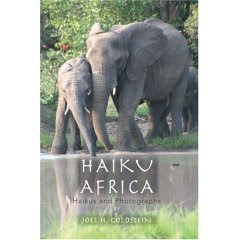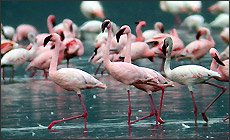[ . BACK to TOP . ]
:::::::::::::::::::::::::::::::::::::::::::::::::::::::::::::::::::::::::::::::::::::::::::::::::::::
Discussing kigo and haiku topics from Kenya
by Isabelle Prondzynski, September 2007
In an equatorial country, such as Kenya, seasons work very differently from those in temperate zones, such as Japan and Europe.
In August 2007, the two most active Haiku Clubs of Kenya, the Bamboochas of Bahati Community Centre Secondary School and the Peacocks of St Mathew Secondary School, invited me to discuss with them the importance of kigo and haiku topics for Kenya haijin.
What follows here are the joint reflections of the clubs, their patrons and myself, which were later discussed with the Worldkigo Database Group in September 2007.
 The Peacocks’ classroom
The Peacocks’ classroom
:::::::::::::::::::::::::::::::::::::::::::::::::::::::::::::::::::::::::::::::::::::::::::::::::::
What feeling attaches to the Kenyan seasons?
We started by reviewing the European / Japanese seasons, as Kenyans are not necessarily familiar with the activities and feelings attached to each of these.
What happens ...
... in the weather (thaw -- heat -- warmth -- cold),
... in nature (germination -- growth -- harvest -- rest),
... in activities (planting -- cultivating -- harvesting -- resting),
... in the parallel to human lives (childhood and youth -- maturity -- old age -- death).
The next thing was to apply this thinking and feeling to the Kenyan seasons. Kenyans are much less used to thinking of their year as being broken down into seasons, than people living in temperate zones are. For the sake of simplification, we dispensed with the hot / cold aspect and concentrated first of all on the more important rainy / dry season distinction -- there are two of each as the year goes on.
As we discussed, we found that the associated words which came to us, could be organised along certain categories, some of which are :
-- activities
-- food
-- beauty
-- home life / leisure
-- ilnesses
-- suffering / tragedy
Unlike Europe and Japan, where the year revolves in a cycle, with the whole of nature participating in a crescendo and diminuendo, followed by another crescendo, in Kenya, each season is more balanced, and each has its "good" and "bad" sides. Each season brings its own growth, its own food, its own suffering and despair.
The students, pondering what the rainy / dry seasons meant to them, answered "
hope" (for the rainy seasons) and "
hopelessness" (for the dry seasons).
Compared with human life, they responded that the rains corresponded to "
childhood and youth", and the dry seasons to all the other ages -- "
maturity, old age and death".
They then reflected whether this held for
urban areas as well as
rural. They agreed that the dry seasons were in many respects easier for an urban person than the rainy seasons -- but even urban people depend on the food grown in the rural areas, and if this does not grow in sufficient quantity or at the right time, prices rise and the urban population suffers hunger as much as the rural population does. So, the parallels shift only slightly in the urban setting as compared with the rural one.
 The Bamboochas’ notes on the Rainy Seasons
The Bamboochas’ notes on the Rainy Seasons
:::::::::::::::::::::::::::::::::::::::::::::::::::::::::::::::::::::::::::::::::::::::::::::::::::
Kenya kigo and haiku topics
The next item on our agenda was to distinguish between kigo and haiku topics.
We ran through a list of words, including these ...
... dust (kigo)
... oranges (kigo)
... Hell's Gate (topic)
... Kenyatta Day (kigo)
which were, at least at first sight, easy.
But others, such as ...
... fly
... thorn tree
... weaver bird
were more complicated, as those of us who were keen observers, had noticed that different aspects of these subjects were noticeable at different times of year.
Thus, the fly, which is there all year round, becomes more of a nuisance in the dry season. The thorn tree, which is beautiful and has leaves all year round, flowers in the cool dry season. The weaver bird, which is observed all year round, rears its young at a specific time of year (to be observed).
... goatmeat
is a kigo for Christians at Christmas, being most Kenyans' preferred meat for the big festivals. But we also realised that this is popular for family celebrations (the homecoming of a much loved child studying or working far away, the meeting of two families whose children are about to get married, etc.). And we realised that Kenyan Muslims, who share the same preference for goatmeat as a special festive food, like to eat this for Idd Ul Fittr and other great Muslim festivals.
So, our first conclusion was :
:::::::::::::::::::::::::::::::::::::::::::::::::::::::::::::::::::::::::::::::::::::::::::
The better we observe, the more kigo we may be able to find for one and the same item.
Examples :
... weaver birds building nests, weaver birds rearing their young
... avocado trees flowering, avocado fruit ripe to eat
... cassia trees leafless, cassia blossom
::::::::::::::::::::::::::::::::::::::::::::::::::::::::::::::::::::::::::::::::::::::::::::
We then discussed the need to use a kigo if possible in every haiku.
This, we had realised, seems to be more difficult in Kenya than in temperate places like Europe and Japan.
The Kenyan seasons have several disadvantages -- from a haijin's point of view!
(a) they have long names
(b) their names are not in common use
(c) many kigo are identical for the two rainy seasons / the two dry seasons
(d) the weather is not all that different all year round
(e) there is no general and simultaneous crescendo and diminuendo of nature in Kenya
Just a few comments here :
(a) In a temperate haiku, it is easy to use "spring breeze", "summer sunset", "autumn loneliness" or "winter chill", for instance, to create an immediate feeling for the season and its atmosphere. It is not so easy for a haijin to say "breeze of the cool dry season" or "wind of the long rains".
(b) Even if it could be done, the feeling would not be as tangible as that of the temperate haiku. People are not as used to thinking in terms of the current season in order to express themselves.
(c) This is probably self evident. Examples are : mud, dust, puddle, downpour, flying termites, bullfrogs, etc. Each of these kigo occur in two seasons each year.
(d) We have brilliant sunshine during the rainy seasons, haijin may want to include this is a haiku (rainfall is mostly in the afternoon and evening). The quality of the sunshine during the rains does not differ significantly from that during the dry seasons. Equally, we have showers during the dry seasons, and sometimes even heavy rain. Less frequently, of course, but normal all the same.
(e) In the short term, one could say that each rainy season plus the following dry season is a unit, so that there are two of these units per year. There is planting and growth, followed by harvest and preparation in each of these units.
In the longer term, there are fruit (particularly those which grow on trees) which mature only once per year -- but taking all such fruit together, they mature throughout the year at different times.
Taking the whole country (which straddles the Equator) as a unit, we find that there is always a part of the country in which the same plant has a different cycle. Thus, Nairobi is never short of fresh avocadoes, mangoes, pawpaws and many other fruit, all year round, because when one part of the country has finished its harvest, another part of the country will bring in a new one.
In August, when the cassia trees of Nairobi are leafless and resting with their ripe seeds (produced by the flowers of January to April), the cassia trees of Kisumu are flowering beautifully.
And so, we arrived at a second conclusion :
::::::::::::::::::::::::::::::::::::::::::::::::::::::::::::::::::::::::::::::::::::::::::::
In Kenya, we may not be able to advise haijin that every haiku should have a kigo.
Kenyan kigo are a lot more difficult than temperate kigo.
We may need to allow the use of haiku topics instead of kigo.
::::::::::::::::::::::::::::::::::::::::::::::::::::::::::::::::::::::::::::::::::::::::::::
 Working group of Bamboochas
Working group of Bamboochas
:::::::::::::::::::::::::::::::::::::::::::::::::::::::::::::::::::::::::::::::::::::::::::::::::::
What are suitable haiku topics for Kenya?
As seen here, Kenyan seasons differ from each other to a lesser extent than temperate seasons do. Yet, we know that seasons help to structure human lives, as humans live within the rhythms of nature.
So, what, together with the seasons, structures human lives in an equatorial country like Kenya? Could these be the best haiku topics to cultivate for the haijin?
The most important are the events of
the human life cycle :
... births
... circumcisions and other rites of passage to adulthood
... engagements
... dowry ceremonies
... weddings
... visits of relatives
... visits of in-laws
... war and peace
... deaths
... funerals
... memorials
Many of these are associated with detailed ceremonial, often taking place in several stages.
In Kenya Saijiki, we have already collected some material on
circumcision, on
mourning, on
peace. These could be the start of a Kenya specific collection of haiku topics.
We have also started on haiku topics associated with geography, the beauty of the different parts of the country.
The
wild animals of Kenya, so numerous and beautiful, can give rise to many kigo, once we have observed them sufficiently. Most of them do not live in urban areas -- so this observation will take some time. But the animals will also be topics. A zebra is a being of beauty all year round -- no haijin will ever regard a Kenya zebra or another wild animal as something ordinary, and it will always be a pleasure to write about them.
 Concentrated Peacocks
Concentrated Peacocks
Text and photos © Isabelle Prondzynski, 2007
**********************************
Related words
*****
The Haiku Clubs of Nairobi
*****
Bukusu Initiation / Circumcision
*****
Mourning
*****
Peace (Swahili : Amani)
*****
Kenya Saijiki
More kigo and topics
:::::::::::::::::::::::::::::::::::::::::::::::::::::::::::::::::::::::::::::::::::::::::::::::::::::

















